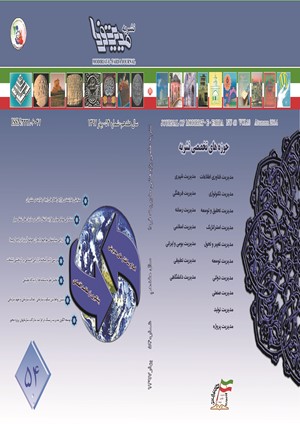تعیین روش ارزیابی عملکرد حملونقل شهری با ترکیب روش کارت امتیازی متوازن و تحلیل فرآیند شبکهای
محورهای موضوعی :سید علی سرکشیکیان 1 , علیرضا معینی 2 , علیرضا علی احمدی 3 , میرسامان پیشوایی 4
1 -
2 - دانشگاه علم و صنعت
3 - دانشگاه علم و صنعت ایران
4 - دانشگاه علم و صنعت
کلید واژه: ارزیابی عملکرد, حملونقل شهری, کارت امتیازی متوازن, ماموریت و چشم انداز,
چکیده مقاله :
این پژوهش به دنبال طرحریزی نظام پایش عملکرد برای حملونقل شهری پس از ترسیم چشمانداز مطلوب آن است. با بررسی روشهای مختلف ارزیابی عملکرد، طراحی نظام پایش عملکرد برای حملونقل شهری با استفاده از کارت امتیازی متوازن صورت پذیرفت. اولویتبندی وجوه و شاخصهای کارت امتیازی متوازن نیز با استفاده از روش تحلیل فرآیند شبکهای انجام گرفت. به منظور تعیین محتوا و تایید نتایج و تکمیل پرسشنامهها توسط تیم خبرگان، از روش گروههای اسمی استفاده گردید. برای تعیین اهداف و همچنین شاخصهای ارزیابی عملکرد، ادبیات موضوع، مطالعات داخلی و خارجی، سیاستهای کلی و اسناد بالادستی کشور در حملونقل بررسی گردید. در نهایت حملونقل پایدار، عادلانه، ایمن، اقتصادی، سریع، راحت و با حداکثر بهرهوری و حداقل اثرات نامطلوب بر روی انسان و محیط زیست مهمترین ارزشها و اهداف تعیین شد. آموزش و فرهنگسازی، مدیریت تقاضای سفر و متوسط سطح سواد و تجربۀ مدیران نیز به ترتیب، به عنوان مهمترین معیارهای ارزیابی عملکرد مدیریت حملونقل در شهرهای کشور انتخاب شدند.
The main objective of this research is to develop a performance measurement system for a desired urban transportation system based on its values, mission, and vision. Based on investigating of different performance evaluation models, the performance measurement system was designed through Balanced Scorecard (BSC). Prioritization of Balanced Scorecard perspectives and indicators was also conducted using Analysis Network Process (ANP) and questionnaires collected from the expert team. Nominal group technique was used by the expert’s team to determine and confirm the results. In addition, to determine performance evaluation indicators, related literature, general policies, successful experiences and scientific breakthroughs were considered and the opinions of experts were extracted in consecutive meetings. Eventually, development of a sustainable, Justly, safe, economical, fast, and comfortable transportation system, with maximum efficiency and minimum Undesirable effects on human health and environment, were defined as the most important values, and the missions of transportation managers have defined accordingly. Training, demand management and the average level of managers’ education and experience were selected respectively as the most important evaluation criteria in urban transportation measurement.
aliahmadi, a. (1394). Methodology to explain the role of Islamic values in designing strategic plans. modiriyatfarda (42). (in persian)
Bernolak, I. (1997). Effective measurement and successful elements of company productivity: The basis of competitiveness and world prosperity. International Journal of production economics, 52 (1), 203 – 213.
Braz, R. G. F., Scavarda, L. F., & Martins, R. A. (2011). Reviewing and improving performance measurement systems: An action research. International Journal of production economics, 133(2), 751-760.
Castillo, H., & Pitfield, D. E. (2010). ELASTIC–A methodological framework for identifying and selecting sustainable transport indicators. Transportation Research Part D: Transport and Environment, 15(4), 179-188.
Ghalayini, A. M., Noble, J. S., & Crowe, T. J. (1997). An integrated dynamic performance measurement system for improving manufacturing competitiveness. International Journal of production economics,48(3), 207-225
Haghshenas, H., & Vaziri, M. (2012). Urban sustainable transportation indicators for global comparison. Ecological Indicators, 15(1),115-121.
Kaplan, R. S., & Norton, D. P. (2005). The balanced scorecard: measures that drive performance. Harvard business review, 83(7), 172.
Karsak, E. E., Sozer, S., & Alptekin, S. E. (2003). Product planning in quality function deployment using a combined analytic network process and goal programming approach. Computers & industrial engineering, 44(1), 171-190.
Litman, T. (2009). Sustainable transportation indicator data quality and availability. Victoria Transport Policy Institute.
Meade, L., & Sarkis, J. (1999). Analyzing organizational project alternatives for agile manufacturing processes: an analytical network approach. International Journal of Production Research, (2)37,241-261.
Mojibi, T., Mohammadi, M., Changizi, M. A., & Changizi, M. M. (2014). Evaluation Of Government Performance On Rural Housing Based On The 4Th And 5Th Development Plan Using Balanced Scorecard Model (Case Study: Villages In Isfahan Province).
Nudurupati, S. S., Bititci, U. S., Kumar, V., & Chan, F. T. (2011). State of the art literature review on performance measurement. Computers & Industrial Engineering, 60(2), 279-290.
Searcy, C. (2012). Corporate sustainability performance measurement systems: A review and research agenda. Journal of business ethics, 107(3), 239-253
Speklé, R. F., & Verbeeten, F. H. (2014). The use of performance measurement systems in the public sector: Effects on performance. Management Accounting Research, 25(2), 131-146.
Tangen, S. (2004). Performance measurement: from philosophy to practice. International journal of productivity and performance management, 53(8), 726-737.
Zebardast, E. (2011). The application of analytic network process (ANP) in urban and regional planning. Fine Arts-Architecture and Urbanism (41). (in persian)
Zolfani, S. H., & Ghadikolaei, A. S. (2013). Performance evaluation of private universities based on balanced scorecard: empirical study based on Iran. Journal of Business Economics and Management, 14(4), 696 – 714.


